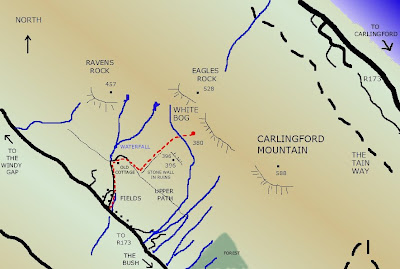Bouldering near the Windy Gap (Dundalk/Newry area), Co. Louth
The White bog ( Lat 54:03:03N (54.05) Lon 6:13:43W (-6.23)) is an upper
The rock is an excellent dark gabbro. Although it is very sharp, the grains and crystals are very small which makes it possible to climb even on a hot summer day. The valley is well weathered, but the scree is facing south west and is high enough to get a lot of wind. So the conditions are usually good.
ACCESS

From Dublin: head north on the Belfast motorway (M1). Take the last Dundalk exit: Dundalk north/Carlinford/N173. Follow the N173 (Cooley peninsula coast road) until the entrance of the village called The Bush. Take the U-turn road to the left towards the Windy Gap and follow the road at the bottom of the hills. Pass the Tain way (sign), pass the highest mountain, a small forest and a few houses. Park on the side of the road before a couple of lane ways to the right (54.04364, -6.24816, the place is called Glenmore, but there's no sign). Approx. 45Mn.
From Belfast: Head south to Newry (A1). In Newry, follow the directions for Omeagh, pass the Carlingford Lough estuary (if you're on the Warrenpoint road A2, you're on the wrong side) and take the Fathom Line (small road). After the border, this becomes the R173. In Omeagh, take a turn right at the Petrol Station and follow this road towards the windy Gap. After passing the Gap (main car park) you reach a yield: take the road to the left. After approx. 2.5km / 1.5 mile, Glenmore and the waterfall should be on your left hand side.
Put on your wellies and walk up the farm lane way. Follow the path that leads to the bottom of the hill side behind the fields (two gates and an old cottage ruins). Turn left straight up the hill following the remains of old stone wall (steep but no ferns). Pass a couple of berms until you arrive in the White Bog valley: the scree should lay in front of you at the bottom of a crag. (20Mn a walk).
Remember: Do not block the field gates, and always keep them closed. I talked to the farmer and he seems to be a nice guy so let's not piss him off.
Starter Arete is the obvious corner arete. It can be climbed from a sit start and has an eliminate on the right (basically eliminating the arete!). Starter traverse is following the round lip of the boulder from the lower right to the top left. There's also a nice little crimpy problem on the left side of the arete. To the right of the arete is another smaller boulder with a couple of sit-start deadpoints: Dec’s sit start takes the round corner and Pierre’s sit-start is the overhanging mini-arete.
PLATE BOULDER
The plate boulder is the huge flat boulder at the bottom of the scree. It has a good overhang on the left side and a big blank roof on the right side.
Lesbian Treaty follows the crack line on the left hand side overhang. Sit-start on the obvious bottom side pull right hand. Using a high flake far left, slap up to the break, match and move right on the crack. Avoid the easy V gap and go for a dynamic finish via the upper crimps. Three Stars.
Media Tick is standing to the right of the plate boulder. Sit-start on the crimps in the groove with a heel hook on the left (harder for the tall). Cross through to the crimps on the right, slap to the lip and rock over.
The Nose is the big obvious pointy nose at the top of the scree. An absolutely awesome problem with a nice grassy landing. Unfortunately it is rarely in conditions due to a green terrace above that keeps water running onto it. Start under the roof. Using a crimp to the right, the sharp arete and a heel hook, slap up to the nose then rock over the lip of the roof. Descent to the right. Sit-Start project from deep back wall.
The pebble is the huge boulder sitting in the middle of the scree. It has a couple of slopey lips with
Blade runner, Sit-Start on the obvious jug. Go left onto the sharp crimps and left again to a hidden jug. Then reach the lip of the overhang to step out via the left arete or rock over onto the slab and top out.
To the rear of the Pebble is a little overhang with a nasty deapoint sit-start. Pull hard on the rather sharp and awkward break to reach the upper jugs. If you managed to keep your feet off the ground then top out.
The ship boulder is the big outcrop that stands on the far right of the scree.
The leak is the sit-start to the vertical crack with a high enough top out. Water-line uses the same sit-start but traverses the horizontal break crack and finish round the corner to the extreme right.
Dublin, November 2008